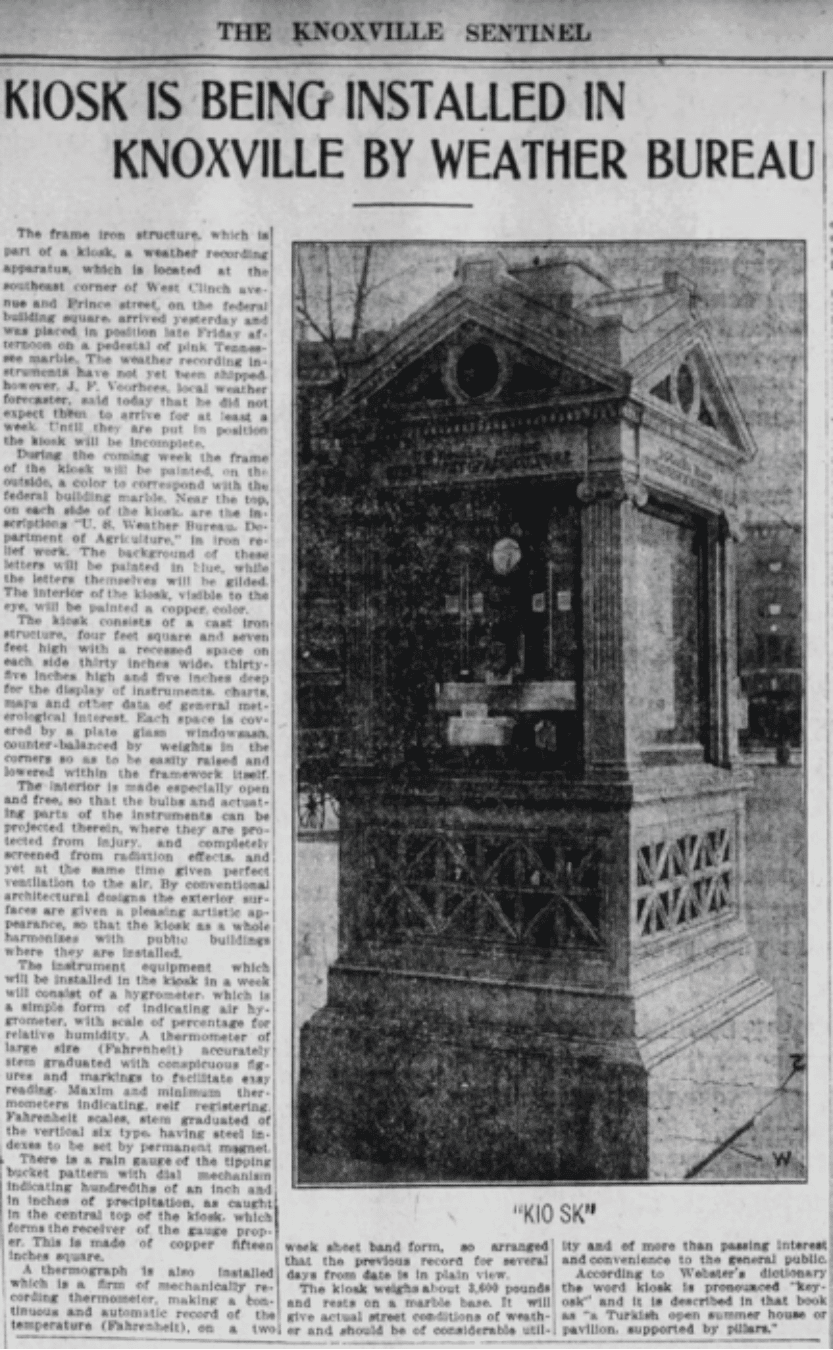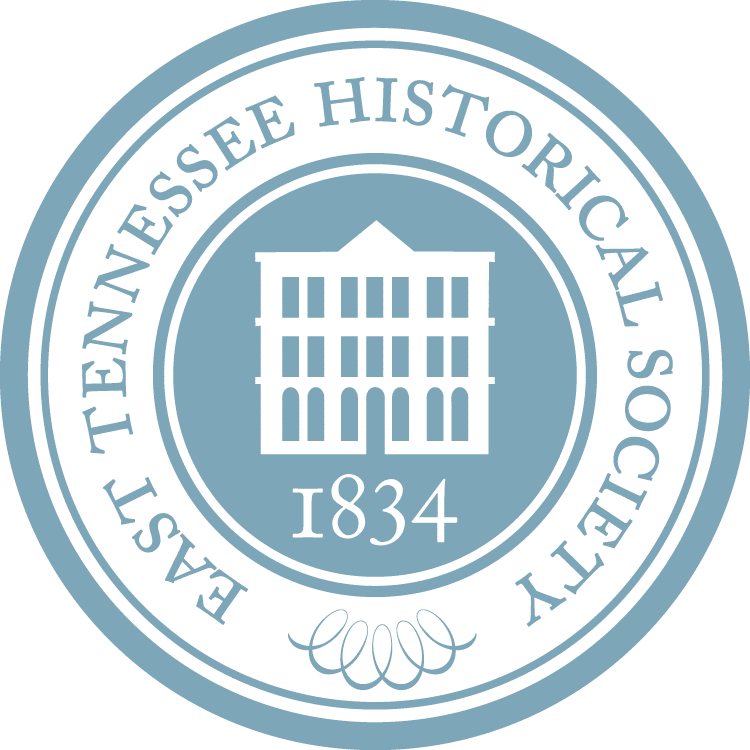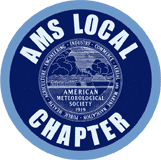THE LAST KIOSK
Weather Kiosks were first used in Europe from the early to mid-1800s. Over time they slowly found their way to the United States where they were placed in several “popular” cities, such as Boston, Manhattan, and Washington, D.C. In researching the weather kiosks of the past, it has been found that they were featured on postcards, photographs, and buried within local newspaper accounts. It is possible that as many as 50 were erected across the United States over a six-year period beginning in 1909. Over time, these aging weather kiosks were destroyed, lost, relocated, or repurposed. The only kiosk surviving in its original location is here in Knoxville, Tennessee, where it remains on the corner of Clinch Avenue and Market Street (formerly Prince).
The first official United States weather station in Knoxville was located inside the Custom House from 1874 until 1898. In August of 1911, the Mineral and Forestry Division of the city’s second Appalachian Exposition approached Congressman R. W. Austin with the hope of obtaining a weather kiosk for display at the exhibition. Despite an appeal to Dr. Willis L. Moore, chief of the United States Weather Bureau, he was unable to secure a kiosk by the exposition date.
John F. Vorhees, a local weather forecaster for the government, announced in a news article in the Knoxville Sentinel (October 17, 1911, p. 10), that a kiosk would be shipped for installation in the spring of 1912. It would be installed on federal government property adjacent to the Custom House.
The kiosk was of a standard design: a cast iron structure weighing about 3,600 pounds. “Moses Smith” is stamped on the roof. The structure measured 4 feet square and 7 feet high. It had a recessed panel on each side: 30 inches by 35 inches and covered by a glass window with a sash that could be raised slightly for ventilation.
The exterior of the kiosk was painted in colors that harmonized with the exterior of the Custom House. The word “kiosk,” described as a Turkish summer house or open pavilion, was new to most Americans.
Functional weather instruments were to be installed in the kiosk, including a hygrometer to measure humidity, a thermometer to measure temperature, and a thermograph to record temperatures on a constant daily basis on a rotating circular sheet of paper for up to two weeks. There was a small copper basin 15 inches square at the top of the kiosk that captured rainfall and funneled it into a rain gauge for measurement.
In February 1912, an unidentified local marble company was awarded the contract to supply a base for the kiosk. It was a piece of pink marble four feet and three inches square by 16 inches high. According to a Knoxville Sentinel article, the kiosk finally arrived and was placed on its pink marble pedestal on the afternoon of May 3, 1912. Completion of the installation was delayed for several weeks because the accompanying bolts had been misplaced in the mail and the weather instruments still had not been shipped.
Over the years, the kiosk needed various repairs, such as when its clock mechanism froze in January 1927 and in May when the thermograph temperature recorder began to leak. A new one was requested from Washington.
By May of 1929, the weather kiosk was weather-stained and scarred from the many matches that had been struck on its base. A call for it to be repainted appeared in the Knoxville Sentinel’s “General Knox” column on May 17, 1929. Then on May 23, weather observer Jim I. Widmeyer announced that the city was currently receiving bids for this project, but the costs were higher than expected. According to a Knoxville Sentinel article, June 20, 1929, approval was secured from Washington for the refurbishing.
In 1931, as plans were underway to move the post office and courthouse to a new building on Main Street, whispers began to circulate that the aging kiosk was to be moved as well. This news created quite an uproar among its faithful “leaners and matchers.” In protest, the “Loyal Sons of the Grand Old Kiosk Protective Association” was formed to oppose the “Kiosk Kickers.” Several humorous suggestions for its reuse were proposed over the ensuing years including turning it into a vending machine for cold drinks or peanuts, a fortune telling booth, or a cab stand. Others sought to relocate it to the new post office site, the peak of Mount LeConte, or to Farragut to dispense apples to the unemployed.
These suggestions continued until the Knoxville Weather Bureau announced on January 22, 1933, that the kiosk would not be moved and would be discontinued. They labeled the decision an ‘economy measure’ because there would be no need to manually rewind the mechanical clock that operated the instruments every week. Repairs for the kiosk had become more expensive and difficult to secure. They also added that the instrument readings, such as temperatures, had never been considered to be the city’s ‘official readings.’
In the end, the kiosk was auctioned on July 21, 1933. Of the bids received, it was Wiley Morgan’s $3 bid on behalf of Greenwood Cemetery that secured the kiosk. By agreement, the kiosk was removed and refurbished at the buyer’s expense. The total cost to the cemetery was $35. Once it was erected, Greenwood used it to post funeral notices.
By 2003, discussions began about returning the old weather kiosk to its original location. As the discourse continued, it was learned that the structure was in disrepair, and Greenwood Cemetery had relocated it to the far corner of the cemetery near the maintenance shed. When approached, Greenwood gifted the kiosk to the East Tennessee Historical Society.
In 2004, the project was then put into the hands of Andrew Hurst, a conservator of art and antiquities. Hurst finished the restoration in five weeks, putting in more than 240 hours of work. It was reinstalled on the corner of Clinch Avenue and Market Street on March 21, 2005, where it served the community with video monitors featuring programs such as the Heartland Series. Unfortunately, vandalism and heat-related issues necessitated their removal. The weather kiosk’s return to its original location was largely at the behest of Edward (Bud) S. Albers, a member of the Board of Directors of the East Tennessee Historical Society.
In 2018, the East Tennessee Historical Society was gifted a micro grant from the Aslan Foundation, which allowed for initial preservation initiatives.
In 2019, Knoxville was discovered to have the last remaining United States Weather Bureau kiosk and was awarded a grant from the National Oceanic and Atmospheric Administration’s Heritage Funding Program for its restoration. As a result, the kiosk is now refurbished. Its pink marble base has been cleaned and an enhanced image replicating the kiosk’s gauges now fills the window where they were once housed.
An additional surviving kiosk is located at the William Scarbrough House and Gardens at the Ships of the Sea Maritime Museum. Reach out to the East Tennessee Historical Society for more discoveries!





